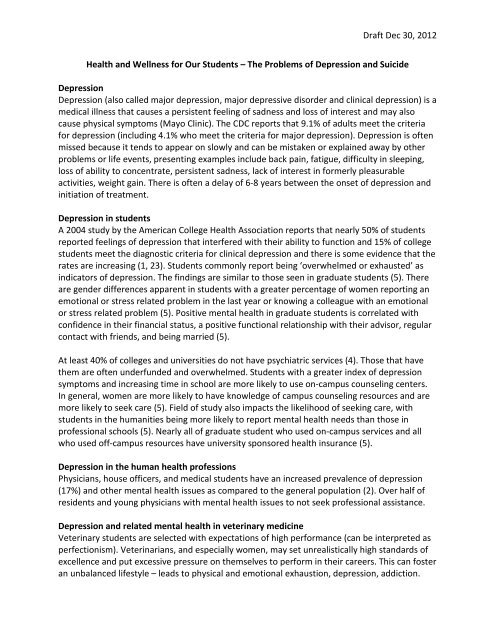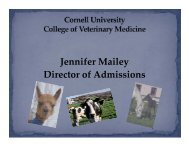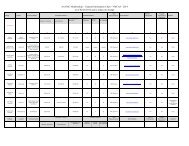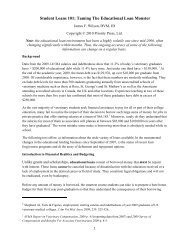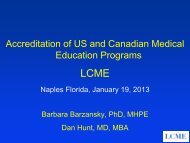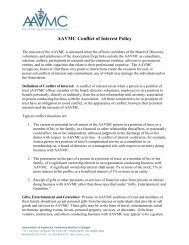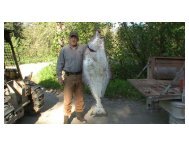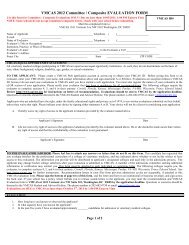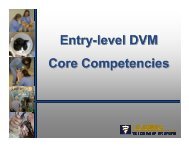Draft Dec 30, 2012 Health and Wellness for Our Students – The ...
Draft Dec 30, 2012 Health and Wellness for Our Students – The ...
Draft Dec 30, 2012 Health and Wellness for Our Students – The ...
You also want an ePaper? Increase the reach of your titles
YUMPU automatically turns print PDFs into web optimized ePapers that Google loves.
<strong>Draft</strong> <strong>Dec</strong> <strong>30</strong>, <strong>2012</strong><strong>Health</strong> <strong>and</strong> <strong>Wellness</strong> <strong>for</strong> <strong>Our</strong> <strong>Students</strong> – <strong>The</strong> Problems of Depression <strong>and</strong> SuicideDepressionDepression (also called major depression, major depressive disorder <strong>and</strong> clinical depression) is amedical illness that causes a persistent feeling of sadness <strong>and</strong> loss of interest <strong>and</strong> may alsocause physical symptoms (Mayo Clinic). <strong>The</strong> CDC reports that 9.1% of adults meet the criteria<strong>for</strong> depression (including 4.1% who meet the criteria <strong>for</strong> major depression). Depression is oftenmissed because it tends to appear on slowly <strong>and</strong> can be mistaken or explained away by otherproblems or life events, presenting examples include back pain, fatigue, difficulty in sleeping,loss of ability to concentrate, persistent sadness, lack of interest in <strong>for</strong>merly pleasurableactivities, weight gain. <strong>The</strong>re is often a delay of 6-8 years between the onset of depression <strong>and</strong>initiation of treatment.Depression in studentsA 2004 study by the American College <strong>Health</strong> Association reports that nearly 50% of studentsreported feelings of depression that interfered with their ability to function <strong>and</strong> 15% of collegestudents meet the diagnostic criteria <strong>for</strong> clinical depression <strong>and</strong> there is some evidence that therates are increasing (1, 23). <strong>Students</strong> commonly report being ‘overwhelmed or exhausted’ asindicators of depression. <strong>The</strong> findings are similar to those seen in graduate students (5). <strong>The</strong>reare gender differences apparent in students with a greater percentage of women reporting anemotional or stress related problem in the last year or knowing a colleague with an emotionalor stress related problem (5). Positive mental health in graduate students is correlated withconfidence in their financial status, a positive functional relationship with their advisor, regularcontact with friends, <strong>and</strong> being married (5).At least 40% of colleges <strong>and</strong> universities do not have psychiatric services (4). Those that havethem are often underfunded <strong>and</strong> overwhelmed. <strong>Students</strong> with a greater index of depressionsymptoms <strong>and</strong> increasing time in school are more likely to use on-campus counseling centers.In general, women are more likely to have knowledge of campus counseling resources <strong>and</strong> aremore likely to seek care (5). Field of study also impacts the likelihood of seeking care, withstudents in the humanities being more likely to report mental health needs than those inprofessional schools (5). Nearly all of graduate student who used on-campus services <strong>and</strong> allwho used off-campus resources have university sponsored health insurance (5).Depression in the human health professionsPhysicians, house officers, <strong>and</strong> medical students have an increased prevalence of depression(17%) <strong>and</strong> other mental health issues as compared to the general population (2). Over half ofresidents <strong>and</strong> young physicians with mental health issues to not seek professional assistance.Depression <strong>and</strong> related mental health in veterinary medicineVeterinary students are selected with expectations of high per<strong>for</strong>mance (can be interpreted asperfectionism). Veterinarians, <strong>and</strong> especially women, may set unrealistically high st<strong>and</strong>ards ofexcellence <strong>and</strong> put excessive pressure on themselves to per<strong>for</strong>m in their careers. This can fosteran unbalanced lifestyle – leads to physical <strong>and</strong> emotional exhaustion, depression, addiction.
A 2008 survey of 1833 veterinary students (45.4 overall response rate) in the UK found that:55% have suffered from stress, 33% have difficult or severe financial situations, 29% havesuffered from anxiety, 22% have suffered from depression, <strong>and</strong> 7.2% have suffered from aneating disorder (6). This is compared to 12% anxiety / depression in the general populationduring the same period. Similar findings are seen in the U.S. For example, 32% of 1 st yearstudents at Kansas State experiencing moderate to severe depressive symptoms (9). Studiesoverall point to gender differences with women physicians <strong>and</strong> veterinarians found to expresshigher levels of stress, depression, anxiety, <strong>and</strong> somatic (physical) symptoms than men (11 –multiple references within). A more recent study, found that rates of depression markedlyexceeded (49-69%) those previously reported in the 1 st three semesters of school (19). Severalother reports with similar conclusions are summarized in Sutton’s report (7).Veterinary students feel that stress had resulted in a lower grade on an assignment (24%), alower grade in a class (2%), or had <strong>for</strong>ced them to take an incomplete or drop a course (0.9%).<strong>The</strong>se rates were not significantly different across years in the curriculum (11).Studies have also found that students often use non-adaptive coping strategies to deal withstress such as food, alcohol, or drugs (37%); procrastination (28%); compulsive activities(compulsively playing computer games or exercising) (23%); sleeping or going to bed to avoidproblems (21%) (13). Approximately 1/3 of veterinary students are regular users of OTCstimulants <strong>and</strong> depressants (22). Another study found that 32% of veterinary students reporteddrinking on more than 6 days over the past <strong>30</strong>, 6% reported using marijuana, <strong>and</strong> 43% reportednegative consequences to their alcohol use (11). Interestingly, 41% of veterinary studentsreport a family history of alcohol or drug addiction.A recent study of practitioners in Alabama found that while 66% indicated that they had beenclinically depressed, only 34% had sought some sort of treatment (20).SuicideIn addition, the veterinary profession has overall failed to acknowledge the problem of suicide.Only 10-11% of students <strong>and</strong> practitioners believe that there is reason <strong>for</strong> concern regardingsuicide rates within the profession <strong>and</strong> yet 66% of respondents indicate that they have beenclinically depressed <strong>and</strong> 27% of women <strong>and</strong> 20% of men admit that they have seriouslyconsidered suicide (20).Suicide emerges in the general population as a significant problem during high school years(8/100,000), increases again in the 20-24Y age (12/100,000), <strong>and</strong> then increases marginally overthe next 20 years of life (14). A study of Big Ten students between 1980 <strong>and</strong> 1990 found thatsuicide risks were greater in students 25Y <strong>and</strong> older (14). In addition, between 1993 <strong>and</strong> 2008,suicidal behavior in the U.S. tripled (4).Men are 4x as likely to die by suicide than women. Men represent ~ 80% of US suicides.However, women attempt suicide 3x as often as men (16).2
White men• Marine engineers 1.89x• Physicians 1.87x• Dentists 1.67x• Veterinarians 1.54x• Finance workers 1.51x• Chiropractors 1.5xBlack men• Police / detective 2.55x• Furnace operators 2.01x• Electricians 1.78xWhite women• Physicians 2.78x• Sales related occupation 2.42x• Police / detective 2.03xBlack women• Protective service occupation 2.79x• Sales supervisors 2.0x• Packaging machine operators 1.96xFor white men, 4/6 professions associated with the highest suicide rates are in the healthprofessions - see table above where veterinarians are ranked 4th below physicians <strong>and</strong> dentists(15). In the UK <strong>and</strong> in Australia, the rate <strong>for</strong> suicides amongst veterinarians is about twice thatseen in physicians (16,18). In the US, female physicians have higher suicide rate than do malephysicians (11, 15).While it suicidal thoughts are not always associated with behavior, there is significant suicideideation within the medical profession. Assessment of medical students <strong>and</strong> as 1 st yearphysicians found that 14% of individuals at each time point reported thoughts of suicide with alifetime prevalence estimated at 43% of individuals. Of these, 8% had planned suicide <strong>and</strong> 1.4%had attempted suicide (12).Predictive traits <strong>and</strong> stressorsMultiple traits <strong>and</strong> stressors have been found to be associated with increasing rates ofdepression, suicidal thoughts, <strong>and</strong> suicidal behavior in college <strong>and</strong> university students, medical<strong>and</strong> veterinary students, <strong>and</strong> within the medical <strong>and</strong> veterinary profession. <strong>The</strong>se are compiledfrom a variety of the references <strong>and</strong> include:Individual <strong>and</strong> personality traits:• Previous mental health problems• Personality traits of ‘vulnerability’ / neuroticism <strong>and</strong> ‘reality weakness’• Alexithymia (not being emotionally sensitive or expressive)• Having externally oriented thinking / extraversion• Depersonalization• Being an older student• International students (also less likely to use counseling resources)Interpersonal• Not being married / cohabitant• LGBT3
Academic / clinical• Perceived medical school stress• Lack of perceived diagnostic skills or competence• A sense of isolation <strong>and</strong> anonymity among students• Lack of sense of personal accomplishment• Burnout• Poor quality or insufficient supervision• Lack of administrative support• Lack of ‘debriefing’ measures after critical incidents• Unsympathetic administration / supervisors• Feelings of being an imposter (abilities do not match those of peers)• Rigidity of the academic program (lives are externally controlled)• Lack of clinical experience in early yearsCoping <strong>and</strong> time management strategies• Avoidance• Blamed self• Procrastination• Wishful thinking• Poor study <strong>and</strong> time management skillsNegative life events• Worries about finance <strong>and</strong> accommodation• Returning to school• Lack of time to take care of self <strong>and</strong> poor self care habits (including sleep, exercise)Addressing the problem: potential areas <strong>for</strong> considerationUnderst<strong>and</strong>ing the impact <strong>and</strong> increasing awarenessWhat is the impact on patient care of depression at the different levels of our profession?Depression is generally easier to treat in earlier stages – how can we increase awareness?Prioritization of mental health education <strong>and</strong> awareness. An example would be the launch ofwebsite – vetlife.org.uk in response to high suicide rate among veterinarians. This site providesin<strong>for</strong>mation, hotline support, <strong>and</strong> openly communicates around issues of mental health <strong>and</strong>wellness.Because of the lag between the onset of depression <strong>and</strong> initiation of treatment, it may be thatwe are missing the true impact by focusing on students. Similar to findings that have assessed4
physicians in the first year of their independent career, we may find that depression thatoriginates in veterinary school persists into the individuals career.Bridging the gap between student expectations <strong>and</strong> their experiences“Research in psychology has indicated that the expectations an individual brings to a situationsignificantly influence how he or she experiences <strong>and</strong> copes with that situation” (LA Pervin,reality <strong>and</strong> non-reality in student expectations of college. J Psych 61:41-48, 1966). Stress is aninevitable part of the veterinary student experience because of the intensity of the curriculum<strong>and</strong> minimal control of the workload. However, there are disconnects noted between student<strong>and</strong> faculty expectations that may exacerbate the stress of veterinary school. First year studentsreport stress associated with the intensity of the program, the required time commitment, theamount of in<strong>for</strong>mation to learn, the amount of material to memorize <strong>and</strong> the paucity ofclinically relevant experiences (7,19). Anxiety <strong>and</strong> depression were both associated with theperception of unclear faculty expectations by students across all 4 years (23). A studycomparing the expectations of 1 st year veterinary students <strong>and</strong> faculty found that (8):• <strong>Students</strong> expected their veterinary education to provide basic competence in veterinarymedicine <strong>and</strong> also train them in specific skills <strong>and</strong> knowledge that would enable them tofunction competently. Training in technical skills was rated very high. <strong>Students</strong> wantedexaminations that integrated facts <strong>and</strong> skills.• Faculty saw a general education that emphasized theoretical basic knowledge where theprimary focus was learning basic facts. <strong>The</strong>y felt that training in technical skills wouldoccur primarily after graduation. Faculty wanted examinations to ensure students hadmastered the in<strong>for</strong>mation.<strong>Students</strong> studied in a surgical education environment noted that anxiety was counterproductiveto learning while excitement appeared to increase their engagement (21). Being able to preparewell was associated with a positive experience while lack of self-confidence accentuated anegative response (21). Are there mechanisms we can improve upon to provide ongoingfeedback that rein<strong>for</strong>ces student perceptions of skills <strong>and</strong> knowledge gained? Can we provideincreased practice periods, ability to gain <strong>and</strong> test skills in different <strong>for</strong>mats?Availability of counseling <strong>and</strong> psychologic services <strong>for</strong> veterinary studentsIn 2001, only 48% of veterinary schools had exclusive counseling services <strong>for</strong> veterinarystudents, <strong>and</strong> most of this was available through part time counselors with an average of 9hours / week (10). In <strong>2012</strong>, the rates <strong>for</strong> in-house counseling support were similar with availabletime varying from 5-40 hours per week (24). Types of services included individual counseling(100%), group counseling (82%), family counseling (69%), stress management (94%),biofeedback (33%), <strong>and</strong> test anxiety reduction (94%). Financial support <strong>for</strong> these came from thecollege (50%), university (19%), or were shared between the college <strong>and</strong> the university (31%).Despite the funding concerns there was a perceived need by colleges: 63% answered that theysometimes needed these services, 27% reported that they needed these services fairly often,<strong>and</strong> 7% reported very often.5
Peer support <strong>and</strong> training in effective coping strategiesIt has been demonstrated residents were able to pick out ‘troubled interns’ (identified asindividuals with poor support <strong>and</strong> few outside interests) be<strong>for</strong>e nurses were able to pick out‘troublesome interns’ (effects on per<strong>for</strong>mance such as poor attitude, unprofessionalism) (3).Administrative <strong>and</strong> financial support <strong>for</strong> social <strong>and</strong> peer groups can be used to increase linkagesbetween students, interns, <strong>and</strong> residents. Coupled with increased awareness <strong>and</strong> training(especially in the area of adaptive <strong>and</strong> effective coping strategies), this may be a mechanism <strong>for</strong>identifying trainees at increased risk <strong>and</strong> to provide peer support.References:1. AVMA News, Depression among students. JAVMA 228:1478, 20062. Tyssen R, et al, Factors in medical school that predict postgraduate mental healthproblems in need of treatment. A nationwide <strong>and</strong> longitudinal study. Medical Education35:110-120, 20083. Daly <strong>and</strong> Wilcock, Examining stress <strong>and</strong> responses to stress in medical students <strong>and</strong> newmedical graduates. MJA 177: suppl14-15, 20024. Current news (from panel at American Psychiatric Association’s annual meeting),Experts say suicide, not homicide is larger threat to nation’s college campuses. DiverseOnline, May 6, 2008.5. Hyun J, et al, Graduate student mental health: needs assessment <strong>and</strong> utilization ofcounseling services. J College Student Development 47:247-266, 2006.6. Medical News Today, Veterinary students face financial <strong>and</strong> mental health pressures.May 18, 2009. For survey goto http://www.bva.co.uk/public/documents/2008_AVS_Survey_Results.pdf7. Sutton R, Veterinary students <strong>and</strong> their reported academic <strong>and</strong> personal experiencesduring the first year of veterinary school. JVME 34:645-651, 2007.8. Hoppe <strong>and</strong> Trowald-Wigh, Student versus faculty attitudes toward the veterinarymedical profession <strong>and</strong> education. J Vet Med Educ 27:17-23, 2000.9. Hafen et al., Predictors of depression <strong>and</strong> anxiety in first year veterinary students: apreliminary report. J Vet Med Educ 22:432-440, 2006.10. Kogan <strong>and</strong> McConnell, Veterinary students <strong>and</strong> psychologic services. JAVMA 218:873-875, 2001.11. Kogan et al, Veterinary students <strong>and</strong> non-academic stressors. JVME 32:193-2000, 2005.12. Tyssen et al, Suicidal ideation among medical students <strong>and</strong> young physicians: anationwide <strong>and</strong> prospective study of prevalence <strong>and</strong> predictors. J Affective Disorders61:69-79, 2001.13. Williams et al, Coping with stress: a survey of Murdoch University veterinary students.JVME 32:201-212, 2005.14. Suicide Prevention Resource Center, Promoting mental health <strong>and</strong> preventing suicide incollege <strong>and</strong> university settings. Oct 21, 2004.6
15. <strong>The</strong> 19 jobs where you’re most likely to kill yourself: rate above average <strong>for</strong> whitemen. http://www.businessinsider.com/most-suicidal-occupations-2011-10#16. http://www.afsp.org/index.cfm?page_id=04ea1254-bd31-1fa3-c549d77e6ca6aa37 Gender rates in the US17. http://www.ava.com.au/sites/default/files/documents/Other/Jones-Fairnie2008.pdf Australia – rate in veterinarians – 45.2/100,000 (national average of11.8/100,000)18. Bartram <strong>and</strong> Baldwin, Veterinary Surgeons <strong>and</strong> suicide: a structured review of possibleinfluences on increased risk. Vet Rec 166:388-397, 2010.19. Reisbig et al, A study of depression <strong>and</strong> anxiety, general health, <strong>and</strong> academicper<strong>for</strong>mance in three cohorts of veterinary medical students across the first threesemesters of veterinary school. JVME 39:341-358, <strong>2012</strong>.20. Skipper & Williams, Failure to acknowledge high suicide risk among veterinarians. JVME39:79-82, <strong>2012</strong>.21. Langebœk et al, Emotions in veterinary surgical students: a qualitative study. JVME39:312-321, <strong>2012</strong>.22. Hofmeister et al, Over-the-counter stimulant, depressant, <strong>and</strong> nootropic use byveterinary students. JVME 37:403-416, 2010.23. Drake et al, Predictors of anxiety <strong>and</strong> depression in veterinary medicine students: a fouryearcohort examination. JVME 39:322-3<strong>30</strong>, <strong>2012</strong>.24. Kogan et al, Psychological services <strong>for</strong> US <strong>and</strong> international veterinary students, JVME39:83-92, <strong>2012</strong>.7


